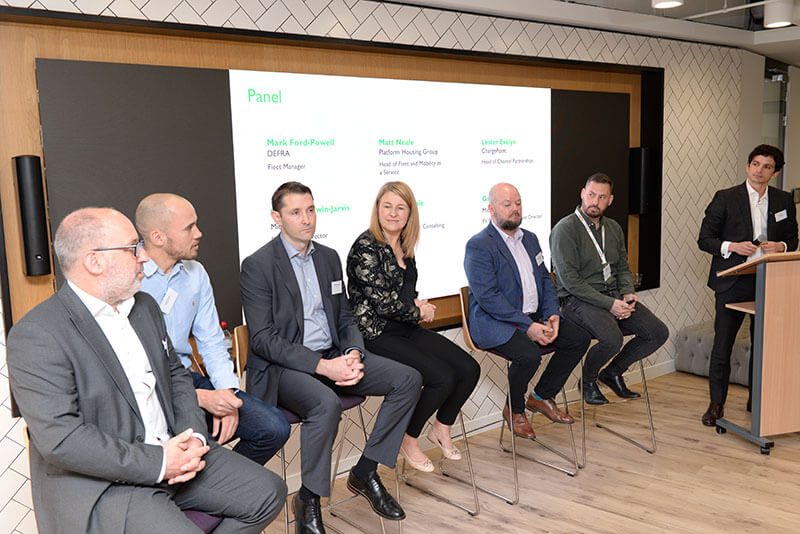Meeting the challenges of electrifying your vehicle fleet
With only 3% of vehicles in the UK being plug-in, we really need to pick up the pace if we’re to meet the UK government’s target of zero emissions on all vehicles by the end of 2027.
There’s still a long way to go but organisations, of all sizes, are stepping up to address the challenges that will come with switching to EV.
At a recent briefing, hosted by Mitie at The Shard in London, industry leaders from the public and private sector gathered to share their challenges and hear from organisations at different stages in their EV journeys.

Two key speakers, from Defra and Platform Housing Group, provided refreshingly honest and insightful accounts of the challenges they’ve faced and overcome in their transition to EV. They were joined by a panel of Mitie’s in-house experts and suppliers for a lively discussion with the audience.
Here are some of the key takeaways.
Don’t rush the EV journey – take time to understand what’s needed
As Programme Manager for Defra Property Group, Jason Ryan has been heavily involved in Defra’s transition to EV. He admitted that at the start of their journey the fleet managers were mainly focused on the finding the vehicles, while the property team focused on how to keep them charged and running. As a result, the initial planning for the required charging infrastructure wasn’t as coordinated as it might have been. He said, “We essentially used what we could to charge what we had and developed the charging strategy in parallel.” It’s a situation that’s familiar to many organisations.
Jason said, “We learned a lot in the first few phases of our EV journey and if I could give one piece of advice to organisations at the start of theirs, it would be to take your time. Don’t rush – take the time to understand what’s needed. Look at the vehicle telematics. They’ll help you build a picture of what infrastructure you’ll need, where, and what charging speeds you’ll need, when.
“When we first started working with Mitie, to develop our charging infrastructure, the first thing they asked for was the data. They used it to build a picture based on actual journeys, distances travelled, where vehicles were stopping and how long they were stationary for. It took the guesswork out of what infrastructure was needed and the ongoing data analysis backs up our strategic decisions for what we’ll need in the future. We now have the evidence we need to make sure we have chargers in the right places, charging at the right speeds, and at the right times.”
Plan for EV well in advance
Although it may seem obvious, plan well ahead to allow for vehicle delivery and infrastructure lead times and work with suppliers to minimise delays.

If you’re in the public sector, you’ll know the time it takes to go out to tender. But you’ll also need to factor in the installation process and schedule, and the extra work and time to onboard your new provider and migrate back-office operations so that everything aligns.
If your property portfolio includes leased buildings, work with landlords early on to get approvals to install charging infrastructure on their property. You can almost guarantee that two things that will take the most time are negotiating leases and getting everything in place to install the chargers.
Take your stakeholders along for the ride
Matt Neale is Head of Fleet and Mobility as a Service for Platform Housing Group. The organisation has a fleet of around 550 light commercial vehicles and more than 600 employees. By contrast, Defra has a fleet of nearly 1600 vehicles and more than 25,000 staff. Both speakers agreed that when it comes to EV it proved important to get staff involved as early as possible.
Matt said, “Our fleet strategy included EV, with an initial goal to decarbonise by 2026 but we didn’t realise how complicated it would be. We were offered 40 electric transit vans early on in our journey then quickly realised we had nowhere to charge them! Also, there was initial resistance from staff who were just presented with the vehicles without consultation. We worked with Mitie to improve our EV transition journey including stakeholder management. An important part of that was to engage with our drivers first and get ambassadors to help spread the word internally. When we resurveyed our drivers, we got a much more positive response.”
Engagement goes beyond the obvious stakeholders like your drivers, FM, energy and property teams. Matt finished by saying, “engaging with all stakeholders, including policy, health and safety, finance and procurement, and internal communications, makes the process easier. By doing it at the start you can avoid back-tracking and delays.”
Hardware is important, but the software is critical
Some organisations that adopted charging infrastructure early on may now find that their legacy hardware isn’t compatible with the latest software.
When you’re thinking about installing charging infrastructure, think about its future use as well as current needs. The hardware is important, but the software is critical, and you’re likely to have a long-term relationship with your software provider as they continually develop their solution. Your suppliers can help make sure the software will support and future-proof your infrastructure as you transition your fleet.
Future challenges and opportunities
Vehicle availability
There are some things that aren’t quite ready. For example, some larger vehicles are not available as EVs yet, and may not be for a while. In the UK, there are no plans, in the next two to three years, to manufacture 4×4 EVs that can carry loads of 3.5 tonne or more without draining the batteries. As a result, some flexibility will be needed for some vehicle types when it comes to government targets and executing your EV strategy.
This might concern your service or property teams if they need to transport heavy equipment, so engage with them early on to find the best solution in the meantime.

Secure data sharing
Data is big business and organisations are understandably concerned about the potential security risks for data shared between their EVs and charging stations. There are different options for charging, from a ‘tap and go’ scenario where the driver can charge without logging in, to more secure solutions that use RFID (radio-frequency ID) technology to authorise a charge.
It’s important to choose a system that gives a range of options for your drivers, with smart authorisation when needed, and provides the operational data that you need. Also, make sure that you select a supplier that has the required security compliance and meets your data requirements.
Consolidated and connected solutions
There are many solutions, like charging apps, which support the commercial and public charging infrastructure, but they are managed in separate environments. Industry consultation will be needed to consolidate solutions into a simpler ecosystem that also aids strategic planning.
Also, with the need to link charging infrastructure with third party systems, like building management systems and fleet management platforms, connectivity within the ecosystem will be increasingly important. The technology that can bring all of that together will be key to developing a truly joined-up solution.
Monetising the quiet times
It’s unlikely that many organisations will find their chargers in constant use by employees, visitors and customers. With the right security systems in place, regular periods of inactivity could present the perfect opportunity to generate revenue by opening up your ultra rapid charging hubs to the public. There will also be potential for providing secure charging spaces for blue light service vehicles that can’t stop just anywhere.
How to get ahead with EV
At Mitie, we’re committed to protecting our planet for future generations, and a huge part of that is helping the world transition to EVs. And we practice what we preach. In fact, we’ve already converted almost half of our own fleet to EVs. That’s 3,000 pure electric vehicles on the road, generating an annual saving of around 15,000 tonnes of CO2.
Our specialists in EV charge points, infrastructure and software solutions, are helping leading organisations make the transition to an electric fleet. If you need help with consultancy, solution design, build and installation, data insights, technology acquisition, ongoing maintenance, or financing, we’re on hand to discuss your options and get your organisation into the EV fast lane.
How can we help?
If you’re looking for more information, need to talk to someone about an enquiry or want to chat about your service needs, then you’ve come to the right place.
Please fill in our short form and a member of our team will be in touch.
If you have a supplier enquiry, please visit our dedicated portal on www.mitiesuppliers.com
 Skip to content
Skip to content